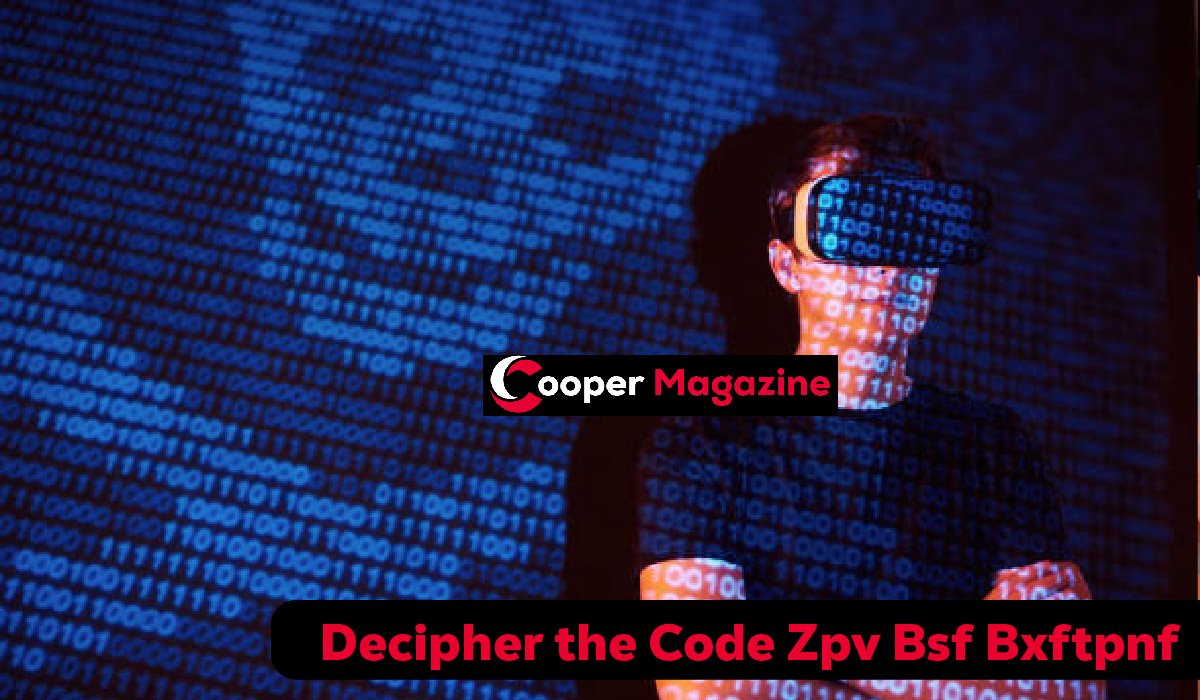Blog
Decipher the Code Zpv Bsf Bxftpnf: Discover the Powerful Hidden Message

Introduction: Decipher the Code Zpv Bsf Bxftpnf
In the world of puzzles, secret messages, and brain games, few things are as engaging as a cryptic code. One such mysterious phrase that has sparked intrigue among codebreakers, learners, and curious minds alike is: “Zpv Bsf Bxftpnf.” This phrase isn’t just a random jumble of letters—it’s a cleverly concealed message that invites you to step into the fascinating world of cryptography. The phrase “decipher the code zpv bsf bxftpnf” has become a popular challenge across forums, social media, and puzzle platforms, encouraging people to decode its hidden meaning. In this article, we will go beyond simply solving the code.
We will explain the cipher used to encrypt it, explore its background in historical cryptography, demonstrate step-by-step decoding methods, and dive into the real-life applications of such secret writing systems. If you’re ready to unlock a hidden message while learning one of the most fundamental skills in the realm of secret communication, you’re in the right place.
What Does “Zpv Bsf Bxftpnf” Mean in Words?
Let’s begin by examining the focus phrase in bold: Zpv Bsf Bxftpnf. At first glance, it may appear to be meaningless. However, this is a classic example of a basic encryption method. The phrase is encoded using the Caesar Cipher, a method where each letter in the message is replaced by another that appears a certain number of places away in the alphabet. In the case of “Zpv Bsf Bxftpnf,” the letters have been shifted one step forward, which means the correct way to decode it is by reversing that shift—moving each letter one step backward.
When we do this, Z becomes Y, P becomes O, V becomes U, and so on. Breaking the full phrase down and decoding it reveals the sentence: “You Are Awesome.” This not only illustrates how simple shifts can hide meaningful messages, but also shows the power of basic encryption in everyday communication.
What Is the Caesar Cipher?
The Caesar Cipher is one of the oldest and most well-known encryption techniques in human history. Named after Julius Caesar, who used it in ancient Rome to send military instructions securely, this cipher works by shifting each letter of the plaintext by a fixed number of places along the alphabet. For instance, with a shift of +1, the letter A becomes B, B becomes C, and so on. To decrypt, the reader simply reverses the shift.
Although it may seem overly simple by today’s standards, the Caesar Cipher was revolutionary in its time and laid the foundation for more advanced encryption systems. The cipher’s strength lies in its predictability and ease of use, making it a favorite in educational settings, escape rooms, and introductory cryptography lessons. It’s precisely this cipher that was used to encode “Zpv Bsf Bxftpnf,” making it an ideal example of how classical techniques still capture interest in the modern world.
How to Decipher the Code “Zpv Bsf Bxftpnf” – Step-by-Step
To break down “Zpv Bsf Bxftpnf” and fully understand how we arrived at “You Are Awesome,” let’s go through a step-by-step process. Starting with the first word, Zpv:
-
Z → Y
-
P → O
-
V → U
Result: You
Next, we move to Bsf:
-
B → A
-
S → R
-
F → E
Result: Are
Finally, the longest part, Bxftpnf:
-
B → A
-
X → W
-
F → E
-
T → S
-
P → O
-
N → M
-
F → E
Result: Awesome
When combined, the complete decoded sentence becomes: You Are Awesome. This simple example demonstrates not just the mechanics of the Caesar Cipher but also its emotional and creative utility. For learners, it’s a fun way to understand how shifting letters can entirely transform the appearance of a message. You can even try writing your own phrases using the same method. Many tools and worksheets allow users to play around with Caesar Cipher wheels or grids to practice encoding and decoding.
Why People Use Secret Codes Like “Zpv Bsf Bxftpnf”
There are several reasons why individuals and organizations use hidden codes like “decipher the code zpv bsf bxftpnf.” One of the primary reasons is entertainment and mental stimulation. People enjoy solving puzzles, and ciphered messages are a great way to challenge the mind. These types of codes are widely used in escape rooms, puzzle books, educational games, and social media challenges to engage users. Beyond entertainment, ciphers serve as teaching tools.
Educators often use them to introduce critical thinking, problem-solving, pattern recognition, and even basic computer science concepts. Codes like this are also used for personal messaging—where friends or couples exchange secret messages for fun or intimacy. On a more serious note, cryptography forms the backbone of digital privacy, ensuring private conversations and confidential data remain secure in today’s interconnected world. Whether for amusement or protection, ciphered text continues to hold timeless appeal.
Types of Ciphers Beyond Caesar
While the Caesar Cipher is simple and effective, it is only one of many encryption methods. For those who want to expand their knowledge, several other cipher types are worth exploring. The Atbash Cipher is one of the earliest forms of encryption, where each letter is replaced by its mirror opposite in the alphabet (A ↔ Z, B ↔ Y). The Vigenère Cipher is a more complex method that uses a keyword to determine how much each letter should be shifted, creating a polyalphabetic substitution that’s much harder to crack.
The Polybius Square uses a 5×5 grid of letters and replaces each letter with its grid coordinates. Morse Code, developed in the 19th century, converts letters into combinations of dots and dashes, while Binary Code—essential to digital communication—represents information using only 0s and 1s. Each of these methods offers unique levels of security and complexity, broadening the spectrum of cipher use from simple games to advanced military-grade encryption.
Tools to Help You Decode Ciphers
If you want to try deciphering messages on your own but need a little help, numerous tools are available online and offline. Online Caesar Cipher decoders allow you to input a phrase and choose a shift number, and they instantly return the decrypted message. Popular tools include dcode.fr, Cryptii, and CyberChef—all of which support multiple cipher formats. Mobile apps dedicated to puzzle solving and cryptography also exist for Android and iOS, making it easier than ever to decode on the go.
For those who prefer a more hands-on approach, cipher wheels, printable substitution charts, and notebooks can help you learn and practice manually. These tools are especially useful in classrooms or group settings where interaction enhances understanding. Whether you’re a beginner or an enthusiast, using the right tools can make deciphering messages like “Zpv Bsf Bxftpnf” an enjoyable and educational experience.
Create Your Own Coded Message Using This Cipher
Creating your own secret message using the Caesar Cipher is not only easy but also a lot of fun. To get started, think of a simple sentence or phrase—something like “Good Luck” or “See You Soon.” Then choose a shift number; for example, a shift of +2 means A becomes C, B becomes D, and so on. Your phrase “Good Luck” would then become “Iqqf Nwem.” You can write out the alphabet on paper and create a cipher wheel to help you encode the letters manually.
This kind of activity is perfect for classroom learning, birthday surprises, treasure hunts, or even social media posts. Coded language builds anticipation and adds an interactive layer to communication. You can even challenge friends to decode your message as a fun game. Whether you’re sending a love note or organizing a puzzle event, the Caesar Cipher makes your message feel like a hidden treasure waiting to be discovered.
Real-Life Applications of Cryptography
Although decoding “Zpv Bsf Bxftpnf” is light-hearted, the principles behind it have serious applications in the real world. Modern-day cybersecurity depends heavily on cryptography. Every time you log into your email, make an online purchase, or send a private message, encryption ensures that your data remains secure. Popular messaging apps like WhatsApp and Signal use end-to-end encryption to prevent third parties from reading your conversations.
Cryptographic algorithms also protect financial data in online banking and blockchain transactions, which are the backbone of cryptocurrency like Bitcoin and Ethereum. Even video games, augmented reality experiences, and military systems use complex forms of encryption to safeguard data and operations. In a world where digital information is constantly under threat, cryptography is no longer just a niche concept—it’s an essential defense layer. This makes understanding basic cipher techniques like Caesar not just fun, but also foundational for grasping more advanced security protocols.
History of Codes and Ciphers Through the Ages
The use of secret writing systems dates back thousands of years. In Ancient Egypt, messages were encoded in hieroglyphs, which combined art and language to form complex symbolic systems. The Romans used various methods for military secrecy, with the Caesar Cipher being one of the earliest documented systems. In the Middle Ages, ciphers evolved into more complex forms, especially in religious and political settings.
Fast forward to the 20th century, and cryptography became a critical component of World War II strategies. The Enigma machine, used by Nazi Germany, was famously cracked by Alan Turing and his team at Bletchley Park, a turning point in the war and in computing history. Today, encryption methods have moved into the digital realm, forming the foundation of SSL certificates, VPNs, and secure email platforms. From stone tablets to supercomputers, the evolution of ciphers reflects our growing need for privacy, trust, and protected communication.
Why “You Are Awesome” Is the Perfect Secret Message
The message hidden within “Zpv Bsf Bxftpnf” is one of positivity—“You Are Awesome.” This makes it the perfect example of how secret codes can be used for uplifting communication. In a world where negativity can often dominate conversations, sending someone a hidden compliment can bring a smile and spark connection. Teachers often use such hidden messages to engage students in fun ways, blending learning with encouragement.
Similarly, social media creators share ciphered posts to boost interactivity and engagement. Even in workplaces, such playful messages can be used for team-building, appreciation, or rewards. The beauty of simple ciphers is that they turn ordinary phrases into small adventures. The moment of “aha!” when someone decodes a message and finds a compliment waiting is a delightful and personal experience. It reminds us that even with basic tools, communication can be both powerful and playful.
Summary: What You Learned by Decoding “Zpv Bsf Bxftpnf”
By decoding the phrase “Zpv Bsf Bxftpnf,” you’ve done more than reveal a sentence—you’ve explored the world of classical encryption. You learned how the Caesar Cipher works by shifting letters backward or forward, how to decode a cipher message step by step, and how similar ciphers like Atbash, Vigenère, and Morse Code continue to be used today.
You also discovered how cryptography impacts modern life—from online security to private messaging—and how it can be applied in personal, educational, and even professional contexts. Most importantly, you saw how a simple cipher can carry a powerful message: You Are Awesome. Whether you’re decoding for fun or diving deeper into cybersecurity, the foundational skills you’ve gained will serve you in countless ways.
Bonus: Other Fun Codes to Try
Ready for your next puzzle? Try decoding these:
-
Uif Dpef Jt Gbdfe → (Hint: Caesar Cipher, shift -1)
-
Bmmpx Pof Npsf Uijoh → (Same method, reveal something sweet!)
-
For a twist, create your own cipher using emojis, colors, or musical notes. Creativity has no limits when it comes to secret codes.
Conclusion
The phrase “decipher the code zpv bsf bxftpnf” is more than a puzzle—it’s a gateway into a fascinating and historically rich practice. Through this single encrypted message, you’ve learned how to decode, how to encrypt, and how cryptography influences the way we protect our information today. It’s a powerful reminder that communication can be both secure and joyful. As you venture into crafting your own secret messages or exploring advanced ciphers, remember that every code cracked is a story told. So go ahead—share your discoveries, surprise your friends, and keep decoding. Who knows what awesome message you’ll uncover next?
FAQs About Decipher the Code Zpv Bsf Bxftpnf
1. What does “Zpv Bsf Bxftpnf” mean?
“Zpv Bsf Bxftpnf” means “You Are Awesome.”
It is a hidden message created using a Caesar Cipher with a backward shift of 1 letter.
2. How do you decipher the code “Zpv Bsf Bxftpnf”?
To decipher “Zpv Bsf Bxftpnf,” shift each letter one step back in the alphabet.
For example, Z → Y, P → O, V → U, and so on.
The full decoded message is: You Are Awesome.
3. What is the Caesar Cipher used in “Zpv Bsf Bxftpnf”?
The Caesar Cipher is a simple code where each letter is shifted forward or backward by a set number of places in the alphabet. In “Zpv Bsf Bxftpnf,” each letter is shifted -1.
4. Why are secret codes like “Zpv Bsf Bxftpnf” used?
Secret codes are used for fun puzzles, private communication, brain training, and teaching problem-solving. They make learning and messaging more interactive and engaging.
5. Are there tools to decode messages like “Zpv Bsf Bxftpnf”?
Yes, you can use online Caesar Cipher decoders, mobile cryptography apps, or manually shift letters with a pen and paper to decode messages like this one.
For More Information, Visit Coopermagazine
-

 Celebrity1 year ago
Celebrity1 year agoWho Is Jennifer Rauchet?: All You Need To Know About Pete Hegseth’s Wife
-

 Celebrity1 year ago
Celebrity1 year agoWho Is Mindy Jennings?: All You Need To Know About Ken Jennings Wife
-

 Celebrity1 year ago
Celebrity1 year agoWho Is Enrica Cenzatti?: The Untold Story of Andrea Bocelli’s Ex-Wife
-

 Celebrity1 year ago
Celebrity1 year agoWho Is Klarissa Munz: The Untold Story of Freddie Highmore’s Wife
















